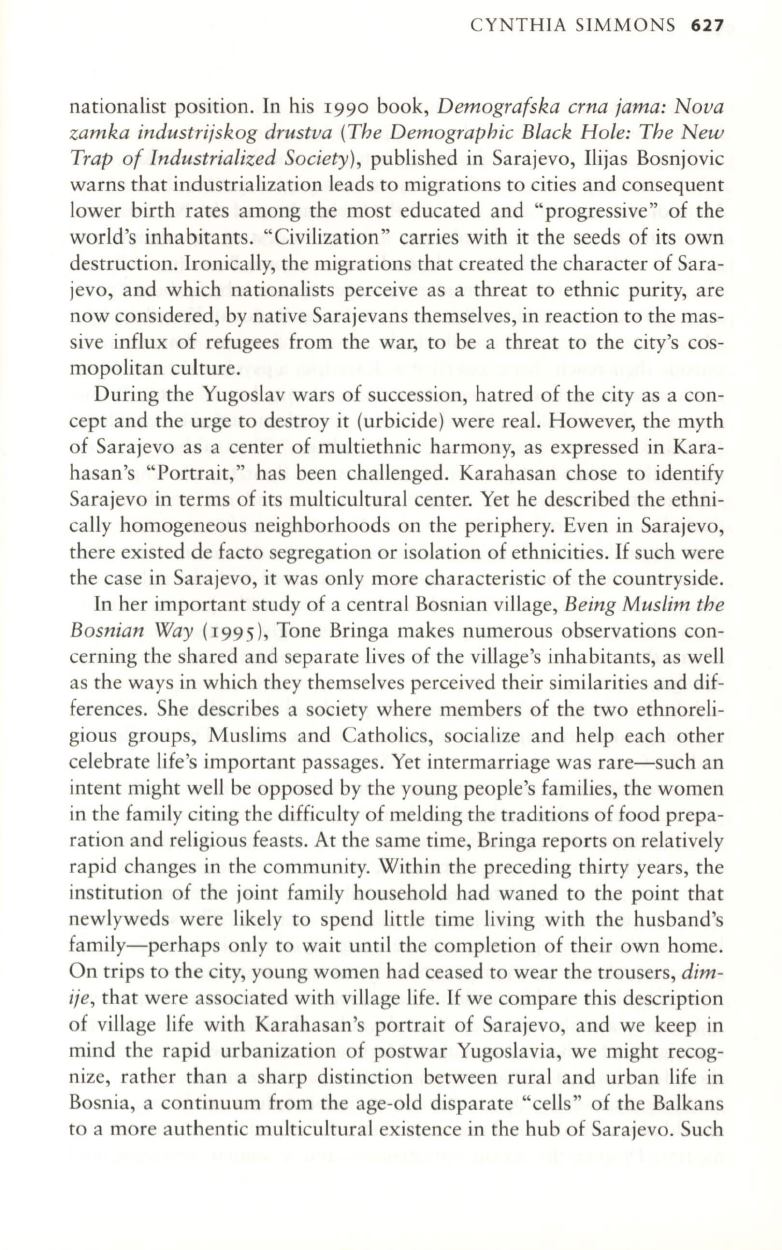
CYNTHIA SIMMONS
627
nationalist position. In his
1990
book,
Demografska crna jama: Nova
zamka industrijskog drustva (The Demographic Black Hole: The New
Trap of Industrialized Society),
published in Sarajevo, Ilijas Bosnjovic
warns that industrialization leads
to
migrations to cities and consequent
lower birth rates among the most educated and "progressive" of the
world's inhabitants. "Civilization" carries with it the seeds of its own
destruction. Ironically, the migrations that created the character of Sara–
jevo, and which nationalists perceive as a threat to ethnic purity, are
now considered, by native Sarajevans themselves, in reaction
to
the mas–
sive influx of refugees from the war,
to
be a threat
to
the city's cos–
mopolitan culture.
During the Yugoslav wars of succession, hatred of the city as a con–
cept and the urge to destroy it (urbicide) were real. However, the myth
of Sarajevo as a center of multiethnic harmony, as expressed in Kara–
hasan's "Portrait," has been challenged . Karahasan chose to identify
Sarajevo in terms of its multicultural center. Yet he described the ethni–
cally homogeneous neighborhoods on the periphery. Even in Sarajevo,
there existed de facto segregation or isolation of ethnicities.
If
such were
the case in Sarajevo, it was only more characteristic of the countryside.
In her important study of a central Bosnian village,
Being Muslim the
Bosnian Way
(1995),
Tone Bringa makes numerous observations con–
cerning the shared and separate lives of the village's inhabitants, as well
as the ways in which they themselves perceived their similarities and dif–
ferences . She describes a society where members of the two ethnoreli–
gious groups, Muslims and Catholics, socialize and help each other
celebrate life's important passages. Yet intermarriage was rare-such an
intent might well be opposed by the young people's families, the women
in the family citing the difficulty of melding the traditions of food prepa–
ration and religious feasts. At the same time, Bringa reports on relatively
rapid changes in the community. Within the preceding thirty years, the
institution of the joint family household had waned
to
the point that
newlyweds were likely to spend little time living with the husband's
family-perhaps only to wait until the completion of their own home.
On trips to the city, young women had ceased
to
wear the trousers,
dim–
ije,
that were associated with village life.
If
we compare this description
of village life with Karahasan's portrait of Sarajevo, and we keep in
mind the rapid urbanization of postwar Yugoslavia, we might recog–
nize, rather than a sharp distinction between rural and urban life in
Bosnia, a continuum from the age-old disparate "cells" of the Balkans
to
a more authentic multicultural existence in the hub of Sarajevo. Such


